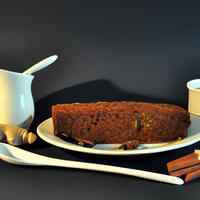
1 serving (80 grams) contains 280 calories, 3.2 grams of protein, 8.0 grams of fat, and 48.0 grams of carbohydrates.

Log this food in SnapCalorie

Nutrition Information
Calories |
823.5 | ||
|---|---|---|---|
% Daily Value* |
|||
| Total Fat | 23.5 g | 30% | |
| Saturated Fat | 11.8 g | 59% | |
| Polyunsaturated Fat | 0 g | ||
| Cholesterol | 70.6 mg | 23% | |
| Sodium | 705.9 mg | 30% | |
| Total Carbohydrates | 141.2 g | 51% | |
| Dietary Fiber | 2.4 g | 8% | |
| Sugars | 82.4 g | ||
| protein | 9.4 g | 18% | |
| Vitamin D | 0 mcg | 0% | |
| Calcium | 117.6 mg | 9% | |
| Iron | 3.5 mg | 19% | |
| Potassium | 352.9 mg | 7% | |
* Percent Daily Values are based on a 2,000 calorie diet. Your daily values may be higher or lower depending on your calorie needs.
Food Attributes
Source of Calories
About Ginger cake
Ginger cake is a moist, spiced dessert popular in British cuisine, with roots tracing back to medieval Europe. This rich cake is traditionally made using ingredients like flour, butter, sugar, eggs, molasses, and ground ginger, often accompanied by warm spices such as cinnamon, nutmeg, and cloves. Its deep flavor and tender texture make it a classic choice, especially during colder months or festive occasions. Ginger, the star ingredient, is celebrated for its potential health benefits, including its anti-inflammatory and digestive properties. However, ginger cake typically contains significant amounts of sugar and butter, making it relatively high in calories and fat. Variations of ginger cake may include nuts, dried fruit, or even crystallized ginger for added texture and taste. Enjoyed as a comforting treat, it pairs well with tea, coffee, or a dollop of whipped cream for a cozy indulgence.



